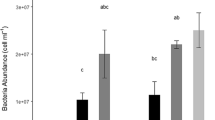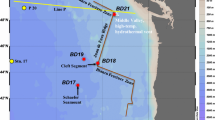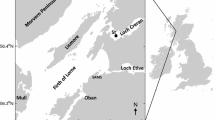Abstract
Microheterotrophic dissolved free amino acid (DFAA) utilization, and microbial community and bacterial community carbon production and growth were studied using 3H-labeled organics as tracers in marine surface-film and subsurface (10 cm) waters off Baja California in November 1983. DFAA utilization was generally more rapid during the day (0.14 to 0.38 nM h-1) than at night (0.04 to 0.14 nM h-1) in surface-film and subsurface waters, but the percent of utilized amino acid which was respired was always greater during the night (22 to 57%) compared to the day (14 to 18%). Utilization of DFAA-carbon was estimated to range from 0.3 to 5.3 μg C l-1 d-1 for all stations studied. In six of the 8 samples examined, the percentage of microbial carbon accounted for by the bacterial component of the population (1.4 to 5.9%) was strikingly similar to the percentage of microbial carbon production accounted for by bacterial carbon production (1.9 to 5.1%). In all of these six samples, total microbial specific-growth rates and bacterial specific-growth rates were approximately equivalent (0.9 to 2.2 d-1 for the microbial community; 0.7 to 1.9 d-1 for bacteria). The two exceptions were samples apparently influenced by transient flagellate populations migrating into the surface or subsurface waters at night. These observations support the conclusion that surface films contain unique and highly active microbial populations.
Similar content being viewed by others
Literature cited
Albright, L. J.: Photosynthetic activities of phytoneuston and phytoplankton. Can. J. Microbiol. 26, 389–392 (1980)
Bell, R. T., G. M. Ahlgren and I. Ahlgren: Estimating bacterioplankton production by measuring [3H]-thymidine incorporation in a eutrophic Swedish lake. Appl. envirl Microbiol. 45, 1709–1721 (1983)
Bell, R. T. and J. Kuparinen: Assessing phytoplankton and bacteriplankton production during early spring in Lake Erken, Sweden. Appl. envirl Microbiol. 48, 1221–1230 (1984)
Bell, W. H.: Bacterial adaptation to low-nutrient conditions as studied with algal extracellular products. Microb. Ecol. 10, 217–230 (1984)
Bern, L.: Autoradiographic studies of [methyl-3H]-thymidine incorporation in a cyanobacterium (Microcystis wesenbergii)-bacterium association and in selected algae and bacteria. Appl. envirl Microbiol. 49, 232–233 (1985)
Bratbak, G.: Bacterial biomass and biovolume estimations. Appl. envirl Microbiol. 49, 1488–1493 (1985)
Carlucci, A. F., D. B. Craven and S. M. Henrichs: Diel production and microheterotrophic utilization of dissolved free amino acids in waters off Southern California. Appl. envirl Microbiol. 48, 165–170 (1984)
Carlucci, A. F., D. B. Craven and S. M. Henrichs: Surface-film microheterotrophs: amino acid metabolism and solar radiation effects on their activities. Mar. Biol. 85, 13–22 (1985)
Carlucci, A. F., D. B. Craven, K. J. Robertson and S. M. Henrichs: Microheterotrophic utilization of dissolved free amino acids in depth profiles of Southern California Borderland basin waters. Oceanol. Acta 9, 89–96 (1986)
Ducklow, H. W. and S. M. Hill: Tritiated thymidine incorporation and the growth of heterotrophic bacteria in warm core rings. Limnol. Oceanogr. 30, 260–272 (1985)
Fenchel, T.: Ecology of heterotrophic microflagellates. I. Some important forms and their functional morphology. Mar. Ecol. Prog. Ser. 8, 225–231 (1982)
Ferguson, r. L. and W. G. Sunda: Utilization of amino acids by planktonic marine bacteria: importance of clean technique and low substrate addition. Limnol. Oceanogr. 29, 258–274 (1984)
Fuhrman, J. A. and F. Azam: Bacterioplankton secondary production estimates for coastal waters of British Columbia, Antarctica, and California. Appl. envirl Microbiol. 39, 1085–1095 (1980)
Fuhrman, J. A. and F. Azam: Thymidine incorporation as a measure of heterotrophic bacterioplankton production in marine surface waters: evaluation and field results. Mar. Biol. 66, 109–120 (1982)
Hardy, J. T.: The sea surface microlayer: biology, chemistry and anthropogenic enrichment. Prog. Oceanogr. 11, 307–328 (1982)
Hardy, J. T. and C. W. Apts: The sea-surface microlayer: phytoneuston productivity and effects of atmospheric particulate matter. Mar. Biol. 82, 293–300 (1984)
Hardy, J. T., C. W. Apts, E. A. Crecelius and G. W. Fellingham: The sea-surface microlayer: fate and residence times of atmospheric metals. Limnol. Oceanogr. 30, 93–101 (1985)
Harvey, G. W.: Microlayer collection from the sea surface: a new method and initial results. Limnol. Oceanogr. 11, 608–613 (1966)
Harvey, R. W., L. W. Lion, L. Y. Young and J. O. Leckie: Enrichment and association of lead and bacteria at particulate surfaces in a salt-marsh surface layer. J. mar. Res. 40, 1201–1211 (1982)
Henrichs, S. M. and P. M. Williams: Dissolved and particulate amino acids and carbohydrates in the sea surface microlayer. Mar. Chem. 17, 141–163 (1985)
Hobbie, J. E., R. J. Daley and S. Jasper: Use of Nuclepore filters for counting bacteria by fluorescence microscopy. Appl envirl Microbiol. 33, 1225–1228 (1977)
Hobbie, J. E., O. Holm-Hansen, T. T. Packard, L. R. Pomeroy, R. W. Sheldon, J. P. Thomas and W. J. Wiebe: A study of the distribution and activity of microorganisms in ocean water. Limnol. Oceanogr. 17, 544–555 (1972)
Holm-Hansen, O. and C. R. Booth: The measurement of adenosine triphosphate in the ocean and its ecological significance. Limnol. Oceanogr. 11, 510–519 (1966)
Jones, B. N., S. Paabo and S. Stein: Amino acid analysis and enzymatic sequence determination of peptides by an improved o-phthaldialdehyde precolumn labelling procedure. J. Liq. Chromat. 4, 565–586 (1981)
Jørgensen, N. O. G. and M. Sondergaard: Are dissolved free amino acids free? Microb. Ecol. 10, 301–316 (1984)
Karl, D. M.: Simultaneous rates of ribonucleic acid and deoxyribonucleic acid syntheses for estimating growth and cell division of aquatic microbial communities. Appl. envirl Microbiol. 42, 850–860 (1981)
Karl, D. M.: Selected nucleic acid precursors in studies of aquatic microbial ecology. Appl. envirl Microbiol. 44, 891–902 (1982)
Karl, D. M.: Determination of in situ microbial biomass, viability, metabolism and growth. In: Bacteria in nature: a treatise on the interactions of bacteria and their habitats. Vol. II. Methods for bacterial ecology. Ed. by E. R. Ledbetter and J. S. Poindexter. New York: Plenum Press (In press) 1986
Karl, D. M. and D. B. Craven: Effects of alkaline phosphatase activity on nucleotide measurements in aquatic microbial communities. Appl. envirl Microbiol. 40, 549–561 (1980)
Karl, D. M. and C. D. Winn: Adenine metabolism and nucleic acid synthesis: applications to microbiological oceanography. In: Heterotrophic activity in the sea, pp 197–215. Ed. by J. Hobbie and P. J. LeB. Williams. New York: Plenum Press 1984
Koroleff, F.: Determination of ammonia. In: Methods of seawater analysis, pp 127–133. Ed. by K. Grasshoff. New York: Verlag Chemie 1976
Lovell, C. R. and A. Konopka: Primary and bacterial production in two dimictic Indiana Lakes. Appl envirl Microbiol. 49, 485–491 (1985)
Marumo, R., N. Taga and T. Nakai: Neustonic bacteria and phytoplankton in surface microlayers of the equatorial waters. Bull. Plankton Soc. Japan 18, 36–41 (1971)
Menzel, D. W. and R. F. Vaccaro: The measurement of dissolved and particulate organic matter in seawater. Limnol. Oceanogr. 9, 138–142 (1964)
Palumbo, A. V., R. L. Ferguson and P. A. Rublee: Efficient utilization of dissolved free amino acids by suspended marine bacteria. J. exp. mar. Biol. Ecol. 69, 257–266 (1983)
Sharp, J. H.: Improved analysis for “particulate” organic carbon and nitrogen from seawater. Limnol. Oceanogr. 17, 984–989 (1974)
Sieburth, J. McN., P. J. Willis, K. M. Johnson, C. M. Burney, D. M. Lavoie, K. R. Hinga, D. A. Caron, F. W. French III, P. W. Johnson and P. G. Davis: Dissolved organic matter and heterotrophic microneuston in the surface microlayers of the North Atlantic. Science, N.Y. 194, 1415–1418 (1976)
Strickland, J. D. H. and T. R. Parsons: A practical handbook of seawater analysis, 2nd ed. Bull. Fish. Res. Bd Can. 167, 1–310 (1972)
Tate, M. W. and R. C. Clelland: Nonparametric and shortcut statistics, 171 pp. Danville, Illinois: Interstate Printers & Publishers, Inc. 1957
Watson, S. W., T. J. Novitsky, H. L. Quinby and F. W. Valois: Determination of bacterial number and biomass in the marine environment. Appl. envirl Microbiol 33, 940–946 (1977)
Williams, P. M., A. F. Carlucci, S. M. Henrichs, E. S. VanVleet, S. G. Horrigan, F. M. H. Reid and K. J. Robertson: Chemical and microbiological studies of sea-surface films in the southern Gulf of California and off the west coast of Baja California. Mar. Chem. 19, 17–98 (1986)
Williams, P. M., D. R. Long, C. C. Price, K. J. Robertson and E. S. VanVleet: A mobile platform for studying sea-surface films. Deep-Sea Res. 29, 641–646 (1982)
Winn, C. D. and D. M. Karl: Laboratory calibrations of the [3H]-adenine technique for measuring rates of RNA and DNA synthesis in marine microorganisms. Appl. envirl Microbiol. 47, 835–842 (1984)
Author information
Authors and Affiliations
Additional information
Communicated by R. S. Carney, Moss Landing
Rights and permissions
About this article
Cite this article
Carlucci, A.F., Craven, D.B., Robertson, K.J. et al. Surface-film microbial populations: diel amino acid metabolism, carbon utilization, and growth rates. Marine Biology 92, 289–297 (1986). https://doi.org/10.1007/BF00392847
Accepted:
Issue Date:
DOI: https://doi.org/10.1007/BF00392847




